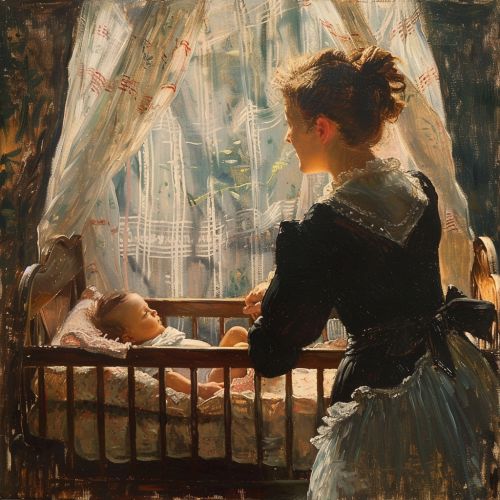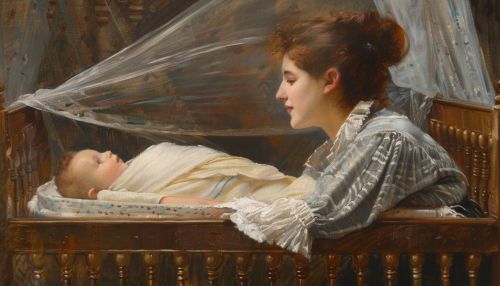The Cradle (Morisot): Difference between revisions
(Created page with "== The Cradle (Morisot) == <div class='only_on_desktop image-preview'><div class='image-preview-loader'></div></div><div class='only_on_mobile image-preview'><div class='image-preview-loader'></div></div> '''The Cradle''' is an 1872 painting by the French artist Berthe Morisot. This work is considered one of Morisot's most significant contributions to the Impressionist movement and is notable for its intimate portrayal of motherhood and domestic l...") |
No edit summary |
||
| Line 1: | Line 1: | ||
== The Cradle (Morisot) == | == The Cradle (Morisot) == | ||
[[Image:Detail-96207.jpg|thumb|center|Painting of a woman looking at a baby in a cradle.|class=only_on_mobile]] | |||
[[Image:Detail-96208.jpg|thumb|center|Painting of a woman looking at a baby in a cradle.|class=only_on_desktop]] | |||
'''The Cradle''' is an 1872 painting by the French artist [[Berthe Morisot]]. This work is considered one of Morisot's most significant contributions to the [[Impressionism|Impressionist]] movement and is notable for its intimate portrayal of motherhood and domestic life. The painting is housed in the [[Musée d'Orsay]] in Paris. | '''The Cradle''' is an 1872 painting by the French artist [[Berthe Morisot]]. This work is considered one of Morisot's most significant contributions to the [[Impressionism|Impressionist]] movement and is notable for its intimate portrayal of motherhood and domestic life. The painting is housed in the [[Musée d'Orsay]] in Paris. | ||
Latest revision as of 13:18, 4 July 2024
The Cradle (Morisot)


The Cradle is an 1872 painting by the French artist Berthe Morisot. This work is considered one of Morisot's most significant contributions to the Impressionist movement and is notable for its intimate portrayal of motherhood and domestic life. The painting is housed in the Musée d'Orsay in Paris.
Background
Berthe Morisot was a prominent figure in the Impressionist movement, known for her delicate and nuanced depictions of everyday life, particularly focusing on women and children. Born into a wealthy family, Morisot received a comprehensive art education and was influenced by artists such as Édouard Manet, whom she later married. Her work often explored themes of femininity, domesticity, and the private sphere, which were less commonly addressed by her male contemporaries.
Description and Analysis
The Cradle depicts Morisot's sister, Edma, gazing lovingly at her sleeping daughter, Blanche. The composition is characterized by its soft, muted color palette and the gentle interplay of light and shadow. The use of light is particularly significant, as it highlights the tender connection between mother and child, a recurring theme in Morisot's oeuvre.
The painting is executed with loose, fluid brushstrokes, a hallmark of the Impressionist style. This technique allows Morisot to capture the ephemeral quality of the moment, emphasizing the emotional depth of the scene over precise detail. The cradle, draped in a delicate white veil, serves as both a literal and symbolic barrier, representing the protective nature of motherhood.
Artistic Context
During the late 19th century, the role of women in society was undergoing significant changes, and Morisot's work reflects these shifts. The Cradle can be seen as a commentary on the evolving perception of women, highlighting their roles not only as caretakers but also as individuals with their own emotional and intellectual lives.
Morisot's choice to focus on domestic scenes was both a reflection of her personal experiences and a deliberate artistic decision. By depicting the intimate moments of women's lives, she challenged the traditional boundaries of acceptable subject matter in art. Her work provided a counter-narrative to the predominantly male perspective of the time, offering a more nuanced and empathetic view of women's experiences.
Reception and Legacy
Upon its debut at the Salon de Paris in 1874, The Cradle received mixed reviews. While some critics praised its emotional depth and technical skill, others dismissed it as overly sentimental. Despite this initial reception, the painting has since been recognized as a masterpiece of Impressionist art and a pivotal work in Morisot's career.
The Cradle has had a lasting impact on the representation of women and motherhood in art. It has been the subject of numerous scholarly analyses and exhibitions, highlighting its significance within the broader context of 19th-century art. The painting continues to be celebrated for its innovative approach to composition and its sensitive portrayal of the maternal bond.
Technical Aspects
The Cradle is an oil on canvas painting, measuring 56 cm by 46 cm. Morisot's use of a limited color palette, dominated by soft whites, pinks, and blues, creates a harmonious and soothing effect. The brushwork is characterized by its light, airy quality, which enhances the sense of intimacy and immediacy in the scene.
Morisot's technique involves layering thin glazes of paint to build up depth and luminosity. This method allows her to achieve a delicate balance between light and shadow, giving the painting a sense of depth and three-dimensionality. The careful attention to detail in the rendering of textures, such as the lace of the cradle's veil and the softness of the baby's blanket, further adds to the realism and emotional resonance of the work.
Influence on Contemporary Artists
Berthe Morisot's innovative approach to subject matter and technique has influenced numerous contemporary artists. Her focus on the private lives of women and the use of light and color to convey emotion have inspired subsequent generations of painters. Artists such as Mary Cassatt and Eva Gonzalès have drawn on Morisot's work in their own explorations of similar themes.
Morisot's legacy extends beyond her contributions to Impressionism. She is also recognized as a trailblazer for women in the arts, breaking down barriers and challenging the gender norms of her time. Her success as a professional artist paved the way for future generations of women to pursue careers in the visual arts.
